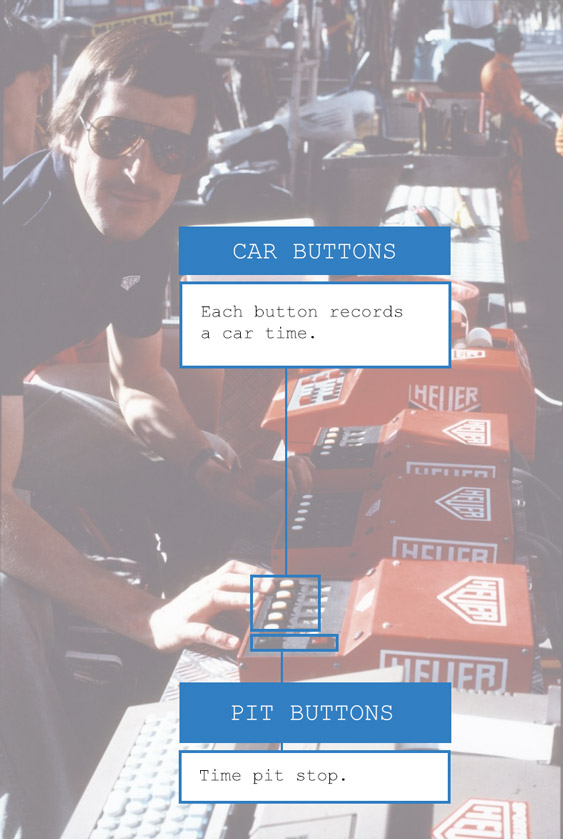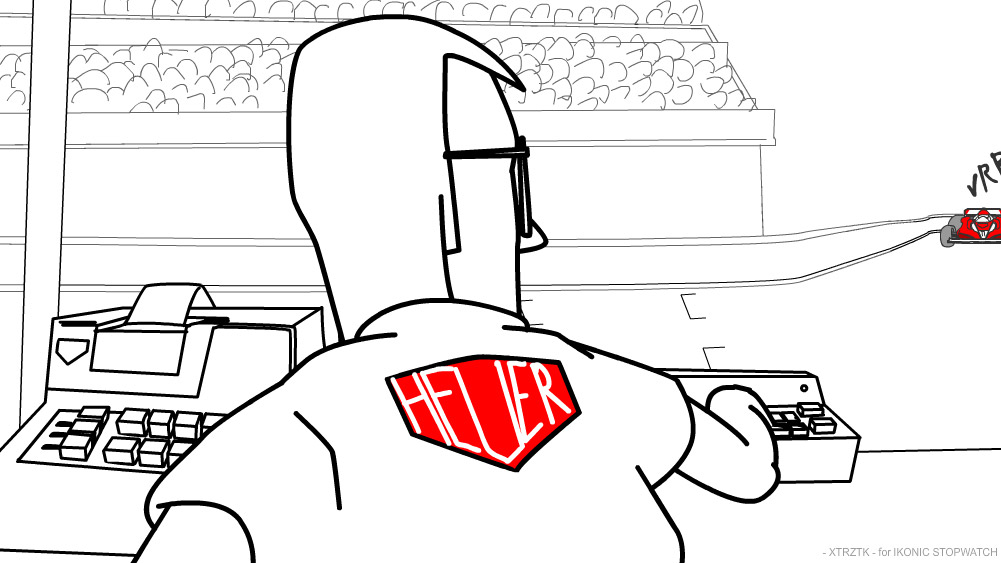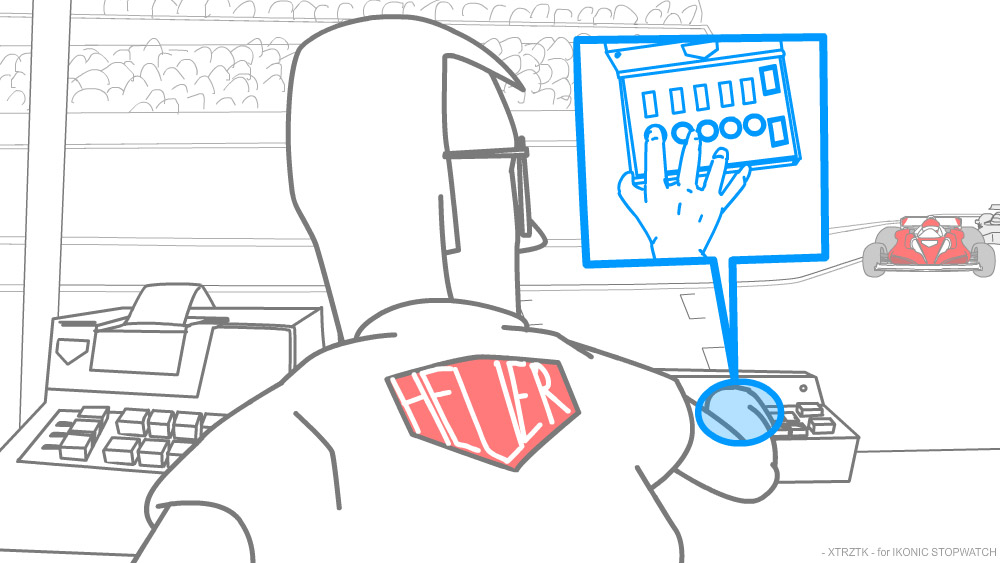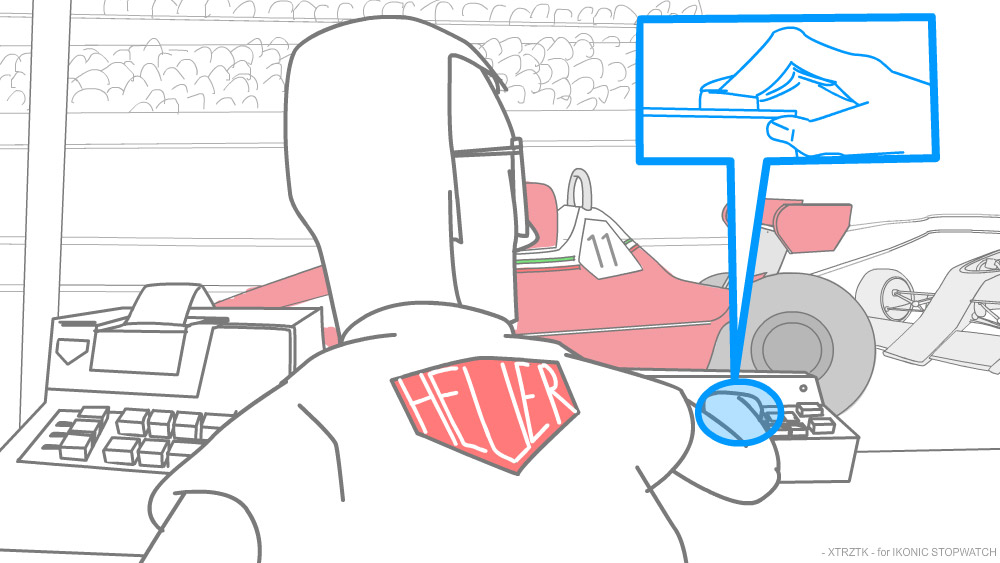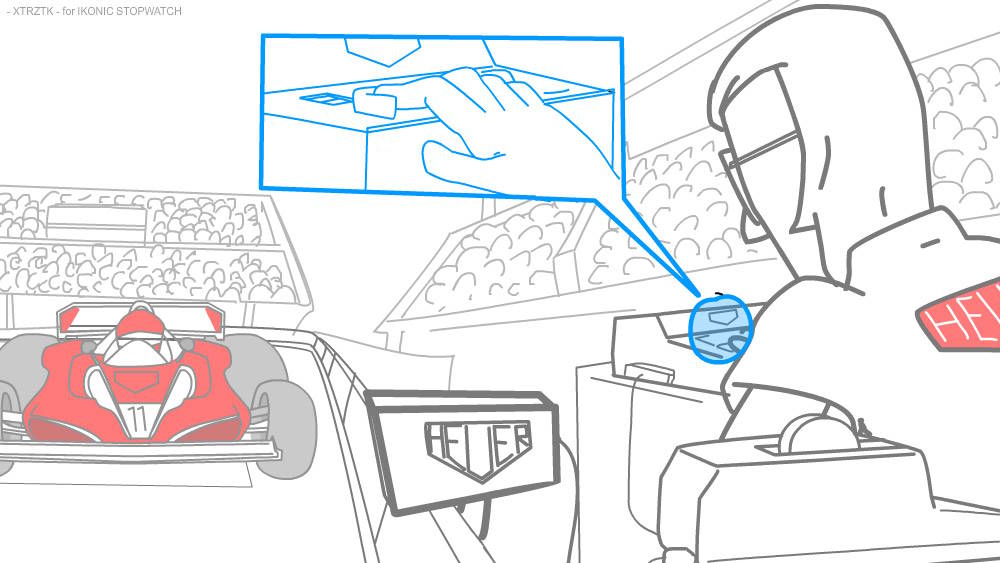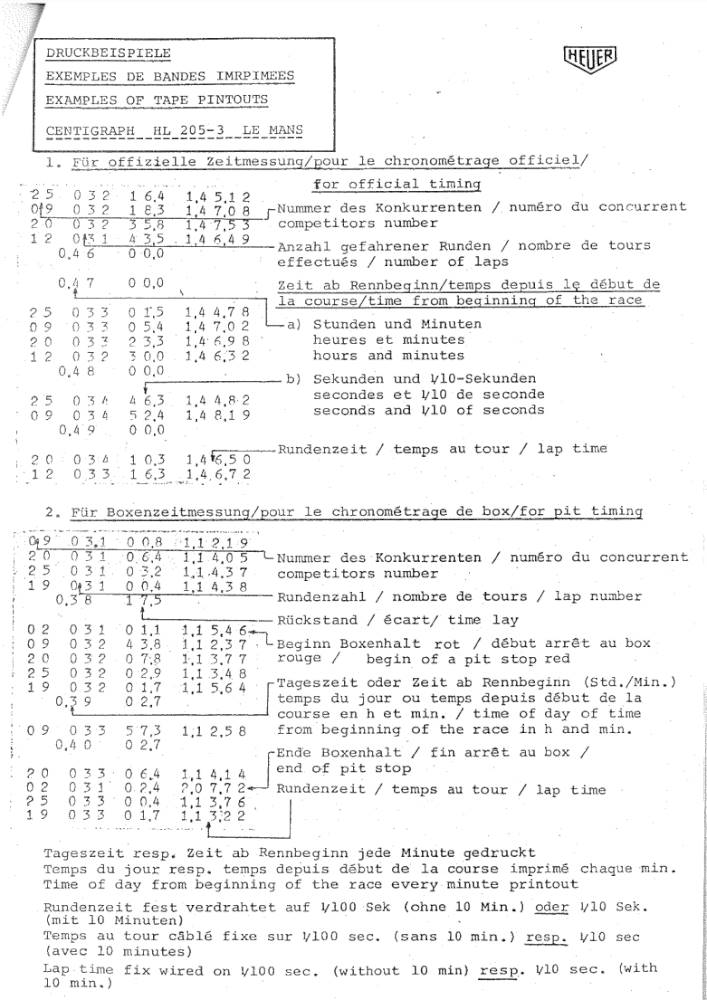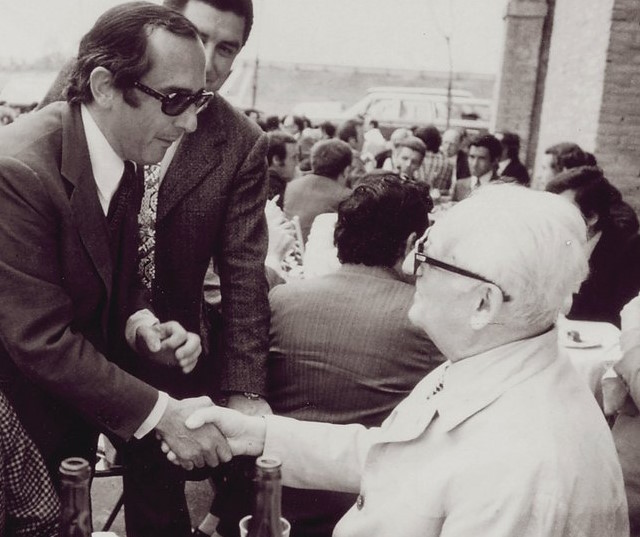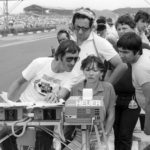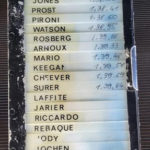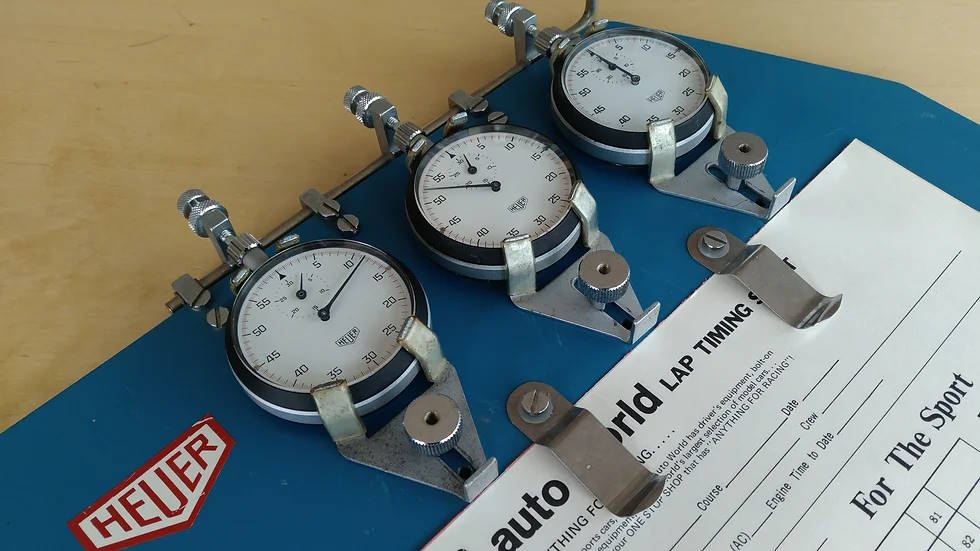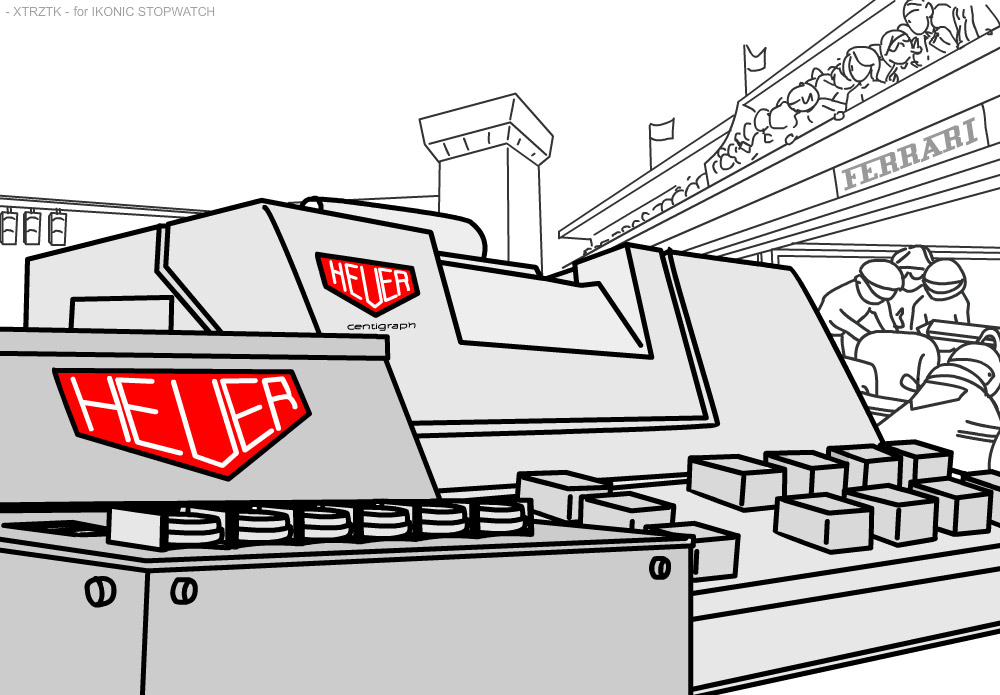
Part II – The Centigraph Le Mans
A. From the Centigraph to the Centigraph Le Mans
Built on a « Precisa » printer, by the Swiss company « Hermes Précisa », it features an integrated electronic part, to turn it into a timing device which could print different time events (start, finish). Released in 1970 or 71, the Centigraph in this format, was already being sold to automobile and ski clubs. However for Ferrari, many cars had to be tracked at the same time; that’s why François Prinz created keyboards connectable to each other (visual 1). This version, designed in 1972, was named ‘Le Mans’, after the French circuit where the famous 24-hour endurance race was held. At the time, Ferrari was mainly focused on endurance racing, although it took part in few Formula 1 races with Arturo Merzario and Jacky Ickx.
My first steps in Formula 1 happened at Montchuick in 1973, with the Centigraph Le Mans. One year later, in 1974, priority was given to Formula 1 with the arrival of Lauda and Regazzoni.

B. Centigraph Le Mans run
1. Keyboards and buttons
Various pictures show keyboards with 5 buttons which could be used to select car numbers. My works started by selecting, on a first keyboard, car numbers to time; for example, in the 1974 formula 1 championship, button 1 was assigned to Regazzoni’s car 11, button 2 to Lauda’s car 12. Buttons were also assigned to fastest rival cars to monitor their time ; so the third button could be bound to a Tyrrell… The red and green buttons were activated to the pits enter and exit (visual 2).
From the Ferrari stand (for endurance races) or the pitlane (for formula 1), I pressed the button bound to a car when it passed me, triggering the timing impulse.
When I started out, I used two keyboards to track 10 cars, then a third keyboard was connected to track up to 15!
2. Vehicle identification and passage
The two big steps when timing with the Centigraph Le Mans are identification and impulse. During identification, the timekeeper has to recognise the incoming vehicle. As it passes, he presses the associated button , triggering impulse to record its time.
The first difficulty was upstream car identification, with its colour, its shape, or the driver’s helmet. Very small details, such as colour recall on the wings, could be decisive to distinguish two vehicles from the same team. When the car was alone, noise of the engine gave an indication (visual 3).
I had few tricks… For example, when I was surprised by a group of cars, anticipation was easier on the next lap, because there was a good chance the group would be the same.
A good knowlege of the keayboard was the other difficulty ! Mentally, I had to know the button bound to Lauda’s, Regazzoni’s or another driver’s car. This way I could press it precisely before the car passed (visuals 4 and 5).
It required a kind of sixth sense, a ‘feeling’.
You had to be on the look out, cause once a car had passed, it was too late! The night before a race, going out to discos and drinking too much champagn or too much whisky (I prefer whisky!) should be avoided. You had to be reactive ! In formula 1, my nickname was the pianist, because it was like I was playing piano when I pushed quicly many bouttons ! However, my instrument, the Centigraph Le Mans, didn’t produce music, but time recording !
3. Difficulty of automation with photocells
Using the Centigraph Le Mans connected to a photocell was different. The pulse was triggered automatically by the photocell, a kind of electronic eye, when the car passed. However, it was necessary to activate the vehicle button (visual 6) before it passed to record its time by the Centigraph (visual 7).
During the race, photocells were not really ideal because if a group of too close cars passed , the photocell would only trigger the impulse for the first car (visual 8).
4. Calculation and results
The Centigraph measured up to 1/1000th of a second, but the Le Mans version was programmed to give 1/100th results. A timing strip (visual 9) was printed with the car number, times the car passed, lap times with associateed number of laps and gaps.
5. Power supply
A 220 volt Honda generator powered the Centigraph Le Mans. Ferrari mechanics supplied it with petrol, to ensure that it didn’t run out of fuel.
C. Unit of measurement, reaction time and accuracy
When I was focus, I could guarantee a ± 5/100ths of a second accuracy, so 1/10th as the cars went by.
Until 1977, most official times were given to 1/10th of a second or 1/100th, and sometimes even 1/1000th.
D. The Centigraph Le Mans and Ferrari
François Prinz got the first contacts with the Scuderia Ferrari. HEUER got on alert when the company learned the car manufacturer was looking for a swiss company to develop timing equipment. Relations, including Jo Siffert, already existed in the world of motor racing.
Being lucky to have the direct contact with Enzo [editor’s note: Ferrari], meetings were arranged with Jack Heuer.
Thus HEUER suggested to Enzo Ferrari and the engineers, equipments to measure and provide the most useful datas to help Ferrari to improve car performance.
As I explained to journalists, sponsorship was different at that time; HEUER didn’t arrive with a suitcase overflowing with cash, like in the cartoons. It was a real technical collaboration. In exchange, the company’s logo could be affixed to the cars and drivers’ overalls.
The partnership officially began in 1971 with the first appointments and developments of what was going to be the Centigraph Le Mans, based on the Centigraph. As mentioned earlier, the Le Mans version included keyboards for tracking several cars. Although Ferrari was already taking part in the Formula 1 world championship, at the time it was mainly involved in endurance racing. So numerous tests were carried out in this kind of event, by François Prinz and a Ferrari employee. Two parameters were particularly important: the number of laps and the lap time.
Lap counting was essential for tyres and, above all, fuel management! Cars had not be called back to the pits one lap too late, to avoid running out of fuel. On the other hand, lap times were necessary to compare performances with those of the competition.
The contract with Ferrari was an opportunity to develop other instruments, such as new photocells, the minitimer for split times and the Speedmeter for measuring speeds.
E. Centigraph Le Mans and timing assistants
Jean Campiche needed an assistant to record and classify the times. In Gilles Villeneuve era, his wife Joann took on this task (visual 10). On other occasions, it might have been a driver’s girlfriend or a Ferrari assistant. At each stop, the assistant collected the printed net times, copied them onto A4 sheets, with columns for each driver, and onto a plate featuring small pull-tabs. When a better time came along, the position of the tab was changed, the old time was erased and the new one written with a felt pen (visual 11). With this system the ranking was fast to read. The plate was shown to the drivers during their pit stops and to the engineers.
F. Centigraph Le Mans and other timers
1. Before the Centigraph Le Mans
Before I arrived at Ferrari and the Centigraph Le Mans, timekeeping was done with a manual mechanical chronograph. It was the same for other teams. For example, Michèle Dubosc at Ligier and Anne Bosnard at Renault used split-second chronographs [editor’s note: the split-second hand is used to record split time]. When a car passed, the chronograph time was stopped, and the passage time noted. Lap time calculation (the difference between two passing times), was done by head … and these girls were incredibly good at doing these operations by head so quickly. They were fantastic.
Manual mechanical chronograph already did a good job, but it was more approximate with a very close car group. If three cars passed together, you couldn’t read three times on the chronograph, so you took the time of the first and added, for example, 1/10th of a second to the second one, then another to the third.
To get a single car lap time , timekeepers also used timing boards (visual 13), sold a lot of in Formula 1, and motor sport in general. Three mechanical counters were mounted on the board. With a single press of a metal control, the three counters were activated; one was stopped (indicating the time of the previous lap), one was reset to zero (for the next lap) and the last was started (measuring the current lap).
2. Jean Campiche’s preferences
I especially loved manual mechanical chronographs used in sport. I got one back from Ferrari, which will soon go to the Tag HEUER museum in La Chaux-de-Fonds. When I left Ferrari, they asked me what I would like to have ? I received a signed leather belt and I kept this chronograph, I had often used (visual 14).
I’ve always loved these timepieces, which are also used for timing skis ! This interest in mechanics has also stayed with me in terms of watches : thanks to human intervention, these mechanisms remain exceptional in their complexity, operation and precision.
I also liked the chronosplit, an electronic dual display wristle chronograph. I had one from the limited edition, produced for Ferrari, with the famous horse.
Miniaturisation and performance of electronics were spectacular, but I was less enthusiastic about this technology. However the ‘must have’ was the Centigraph.
- CREDITS
- banner : xtrztk.com
- visual 1 : Centigraph Le Mans – published by David on Tag HEUER forums (ex calibre11) – original modified : captions added
- visual 2 : Jean Campiche et le Centigraphe Le Mans – published par David on Tag HEUER forums (ex calibre11) – original modified : captions added and color edited
- visual 3 : xtrztk.com
- visual 4 : xtrztk.com
- visual 5 : xtrztk.com
- visual 6 : xtrztk.com
- visual 7 : xtrztk.com
- visual 8 : xtrztk.com
- visual 9 : timing script – by Jean Campiche
- visual 10 : Jack Heuer and Enzo Ferrari – unknown source -original modified : reframed
- visual 11 : Jean Campiche, Joann Villeneuve et Mauro Forhieri – by David Phipps – motorsport image
- visual 13 : planche de chronométrage HEUER – HEUER timers
Feel free to share suggestions or improvements for this article using this form.
